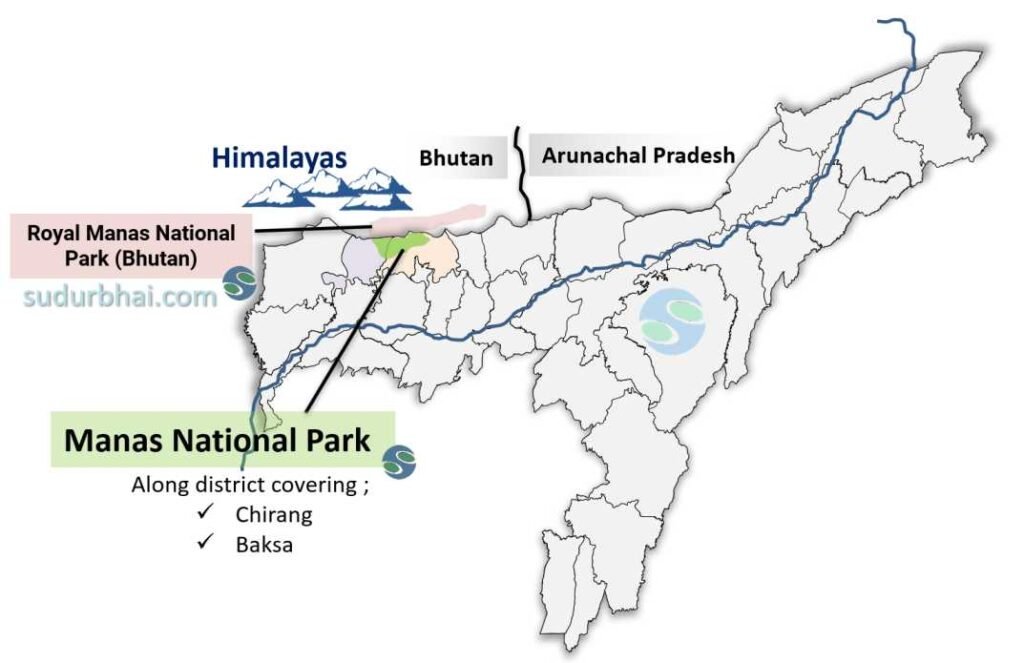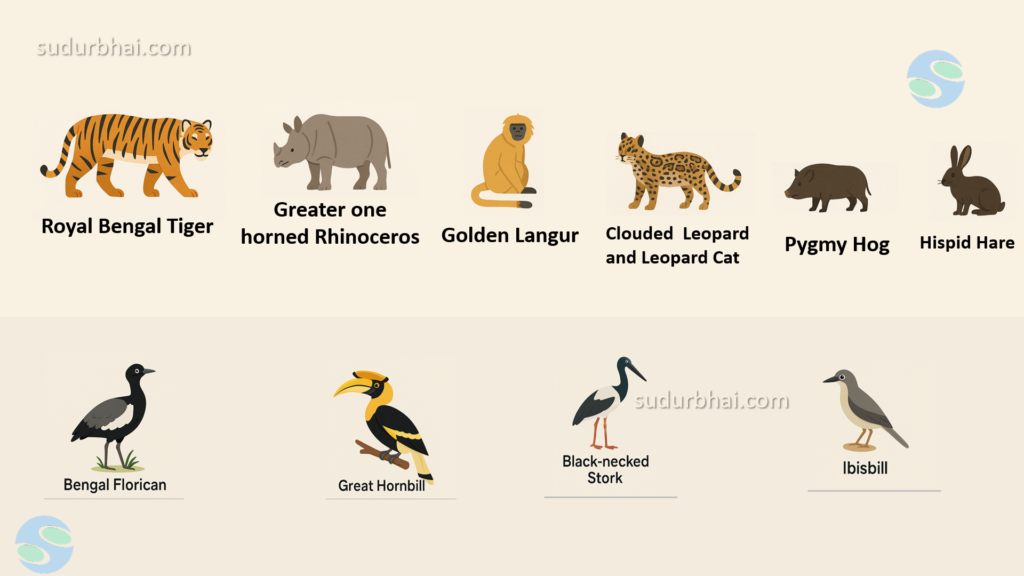Manas National Park

1. Location and Area of Manas National Park
- Geographical Location: Located in the western part of Assam, bordering Bhutan.
Districts Covered: Chirang and Baksa.
Total Area: 950 sq. km
Landscape Features:
Located at the foothills of the Eastern Himalayas.
Acts as a transboundary conservation area with Royal Manas National Park (Bhutan).

2. Year of Establishment of Manas National Park
- Declared a Reserved Forest: 1907.
Became a Wildlife Sanctuary: 1928.
Declared a National Park: 1990 under the Wildlife Protection Act, 1972.
Recognized as a Tiger Reserve: 1973 (One of India’s first Tiger Reserves under Project Tiger).
UNESCO World Heritage Site: 1985.
Biosphere Reserve: 1989.
Elephant Reserve: Part of Kameng–Manas Elephant Reserve.
3. UNESCO World Heritage Status to Manas National Park
Declared a UNESCO World Heritage Site: 1985.
Reasons for Recognition:
One of the richest biodiversity hotspots in India.
Only national park in India designated as a Tiger Reserve, Elephant Reserve, and Biosphere Reserve.
Unique terrestrial and aquatic ecosystems with a mix of grasslands, forests, and riverine habitats.
4. Biodiversity of Manas National Park
A. Flora in Manas National Park
Vegetation Types:
Tropical Moist Deciduous Forests.
Evergreen and Semi-Evergreen Forests.
Alluvial Grasslands (similar to Kaziranga but more diverse).
Riparian Ecosystems (along the Manas River).
Dominant Plant Species:
Trees: Sal (Shorea robusta), Khasi Pine, Orchids, Indian Laurel.
Grasses: Barenga Grass, Elephant Grass, Imperata cylindrica.
Wetland Vegetation: Water hyacinth, aquatic lilies.
B. Fauna in Manas National Park
Mammals (60+ species)
Flagship Species:
Royal Bengal Tiger (Highest tiger density in Assam).
Asian Elephant (part of a transboundary elephant corridor).
Greater One-Horned Rhinoceros (Reintroduced successfully after local extinction).
Clouded Leopard and Leopard Cat.
Golden Langur (Endemic and endangered).
Pygmy Hog (Critically Endangered, only found in Manas).
Hispid Hare (Rare and found in the grasslands).
Avifauna (Birdlife – Important Bird Area by BirdLife International)
Over 450 species of birds.
Key Bird Species: Bengal Florican (Critically Endangered), Great Hornbill, Black-necked Stork, Ibisbill.
Reptiles & Amphibians
Gharial, King Cobra, Assam Roofed Turtle, Monitor Lizard.

5. Major Rivers and Terrain of Manas National Park
A. Major Rivers in Manas National Park
Manas River:
Originates in Bhutan and flows through the park.
Forms several tributaries and oxbow lakes inside the park.
Vital for the riparian ecosystem and wildlife movement.
Other Rivers:
Beki, Hakua, Pathimari, all tributaries of the Brahmaputra.
B. Terrain & Climate in Manas National Park
Landscape in Manas National Park :
A mix of grasslands, foothills, and riverine areas.
Connected to Royal Manas National Park (Bhutan), allowing transboundary wildlife movement.
Climate of Manas National Park:
Tropical Monsoon Climate.
Heavy Rainfall (2000-3000 mm annually), leading to seasonal flooding.
Winters: Cool and dry, best time for tourism and research.
6. Conservation Challenges and Successes in Manas National Park
A. Conservation Challenges in Manas National Park
Poaching and Illegal Wildlife Trade
Poaching of tigers, rhinos, and elephants for their body parts.
Pygmy Hog and Hispid Hare populations under severe threat.
Strict patrolling and use of technology (drones, camera traps) have reduced poaching incidents.
Encroachment and Deforestation
Human settlements expanding around the park.
Illegal logging and grazing damaging forest habitats.
Conflict between conservation efforts and local livelihoods.
Political Disturbances (Bodoland Conflict)
The park was heavily affected by Bodo militancy in the 1990s and early 2000s.
Poachers took advantage of lawlessness, leading to local extinction of rhinos.
Peace agreements (2003, 2020) have helped restore conservation efforts.
Tourism and Overexploitation
Growing tourism is increasing human interference in fragile areas.
Strict eco-tourism policies have been introduced to regulate the impact.
B. Conservation Successes in Manas National Park
Successful Rhino Reintroduction
Rhinos were locally extinct in the 1990s due to poaching.
Reintroduction program (Indian Rhino Vision 2020) successfully brought rhinos back.
Population increasing steadily due to anti-poaching efforts.
Manas as a Model for Transboundary Conservation
Connected to Royal Manas National Park (Bhutan), allowing safe migration of tigers, elephants, and other species.
Joint Conservation Initiatives between India and Bhutan have improved protection measures.
Community Participation in Conservation
Locals are now involved in eco-tourism and sustainable livelihoods (handicrafts, guiding, eco-lodges).
Reduced dependency on illegal activities like logging and hunting.
Recovery of the Pygmy Hog and Bengal Florican
Conservation breeding programs have helped stabilize these critically endangered species.
Pygmy Hog Conservation Program (PHCP) is successfully breeding and releasing hogs into the wild.
